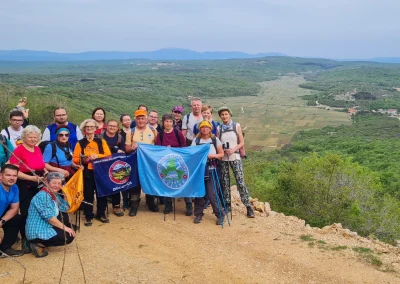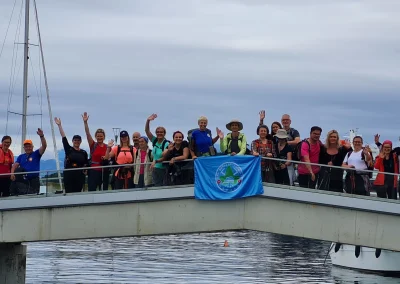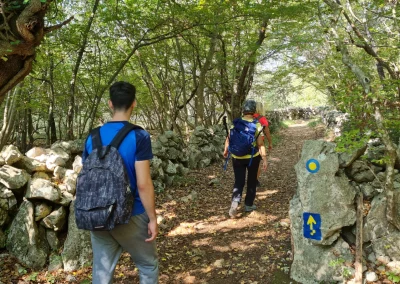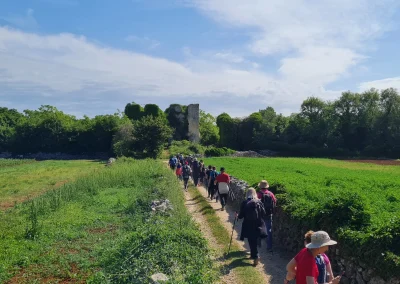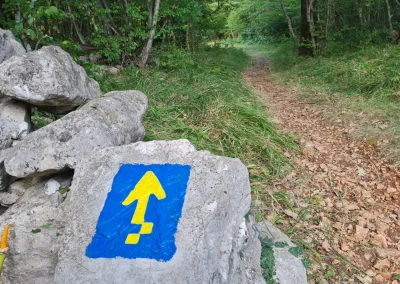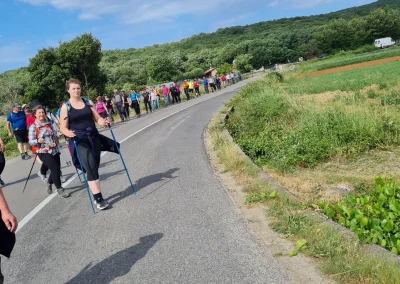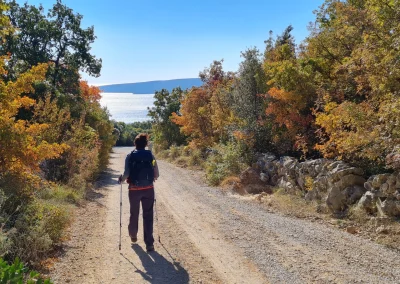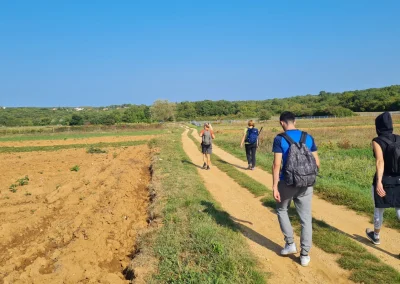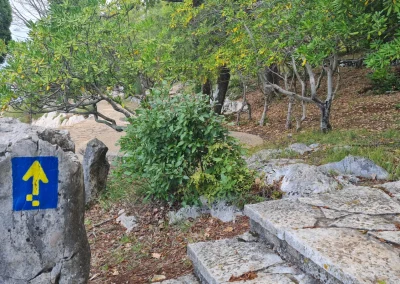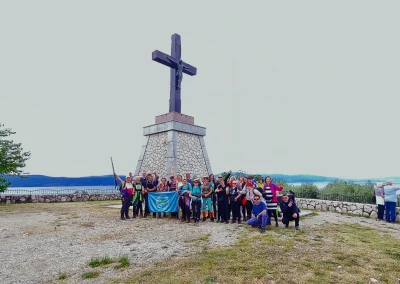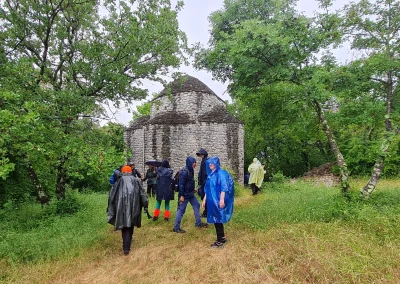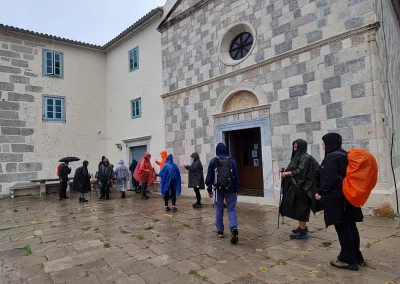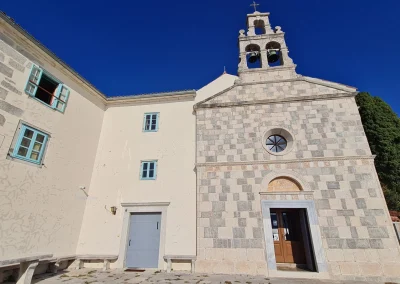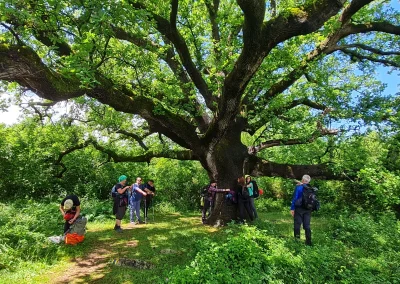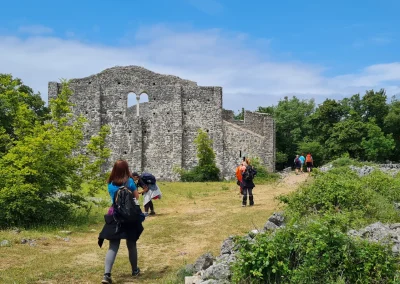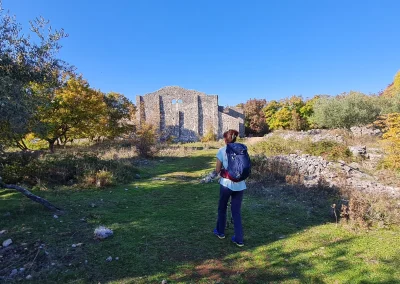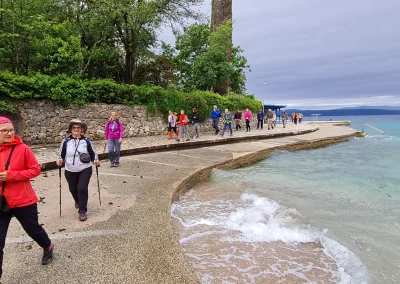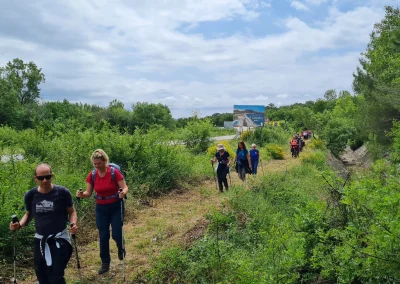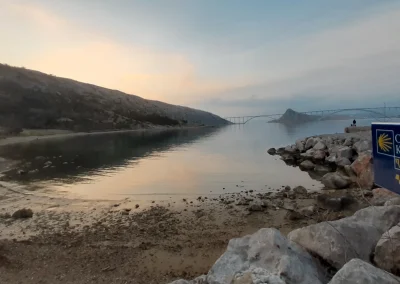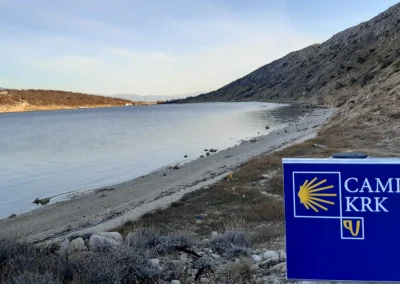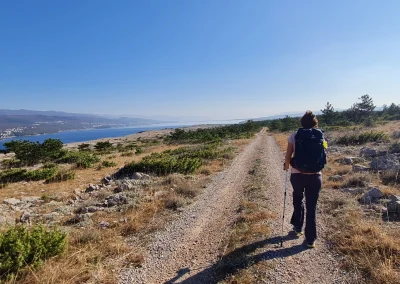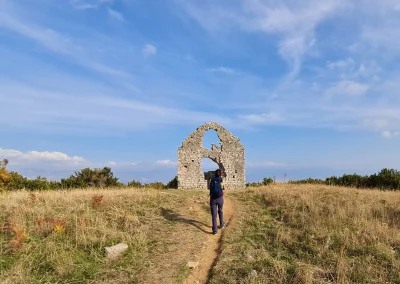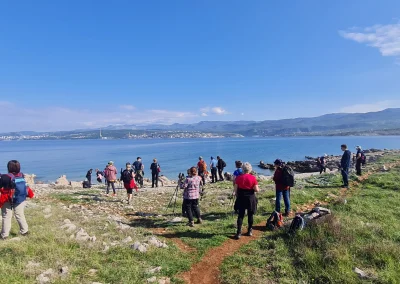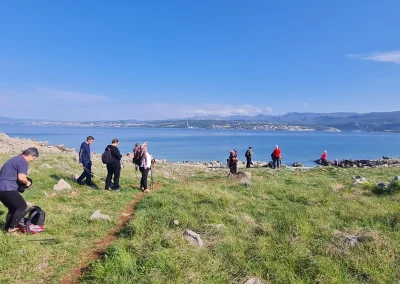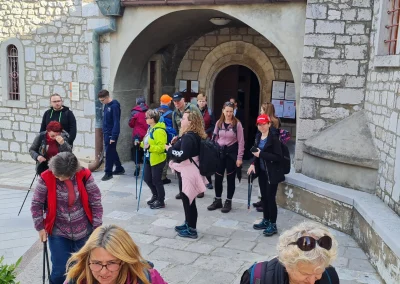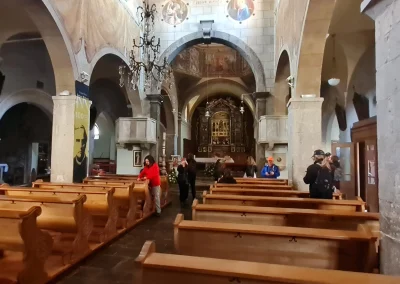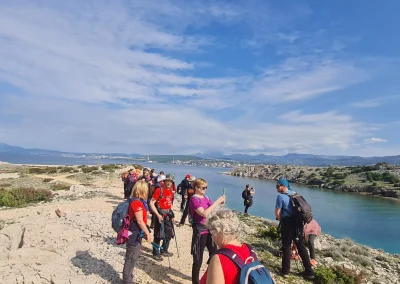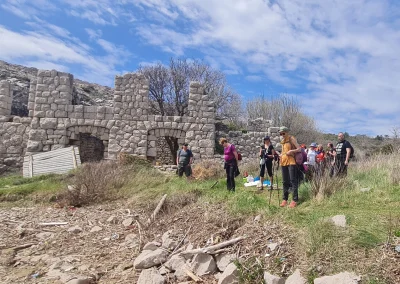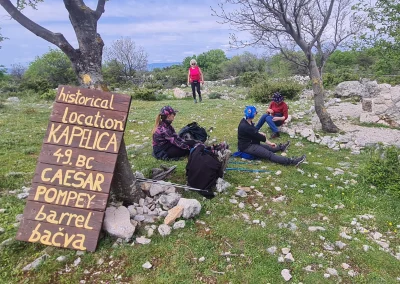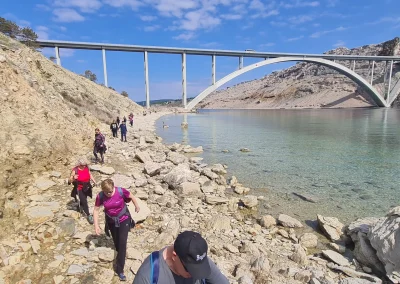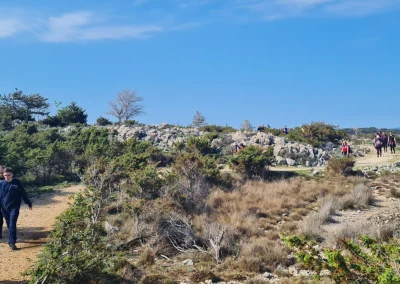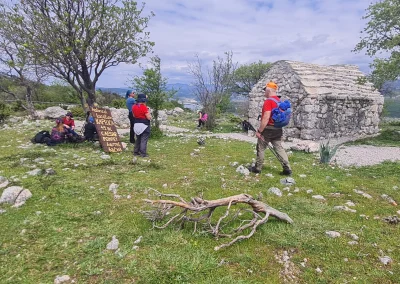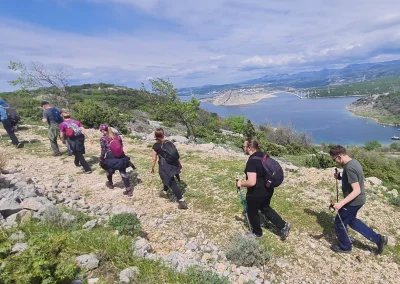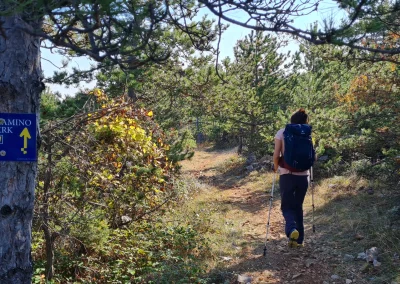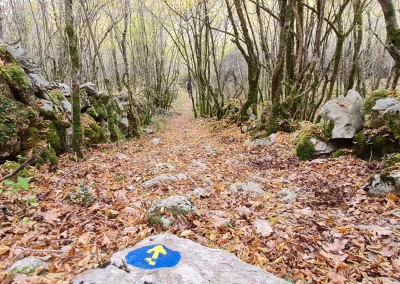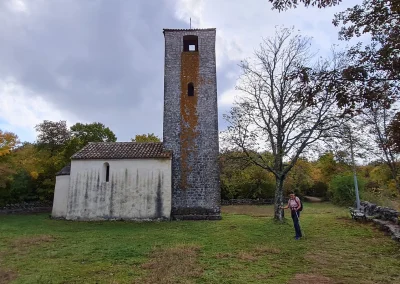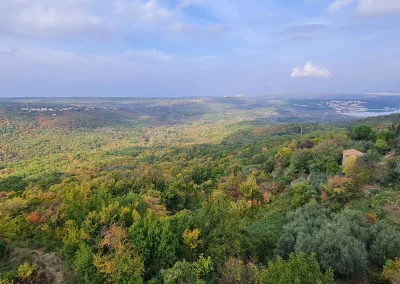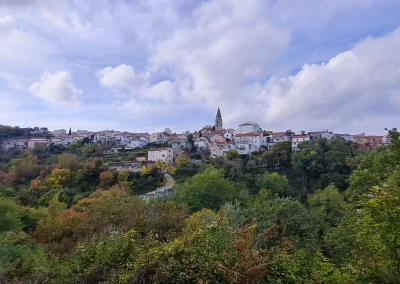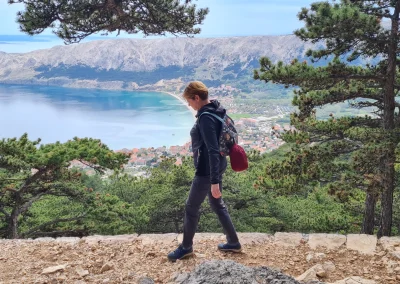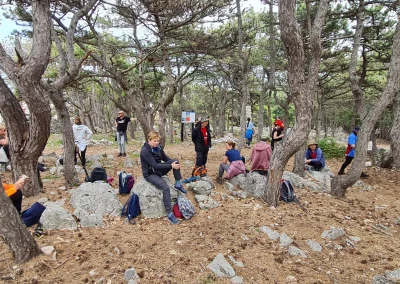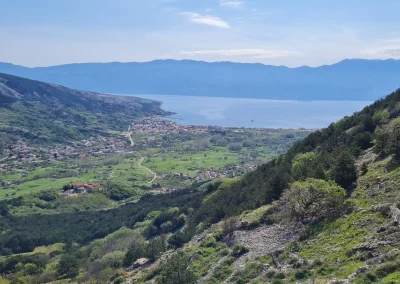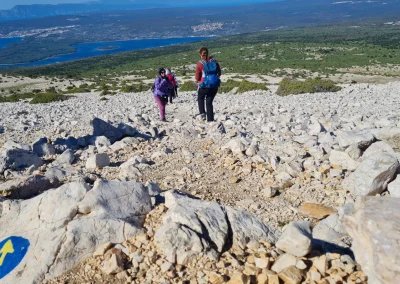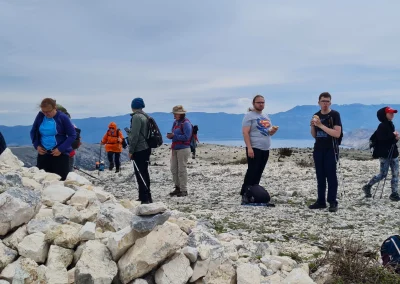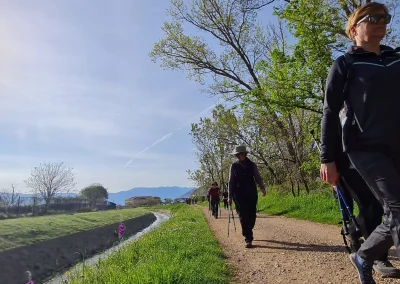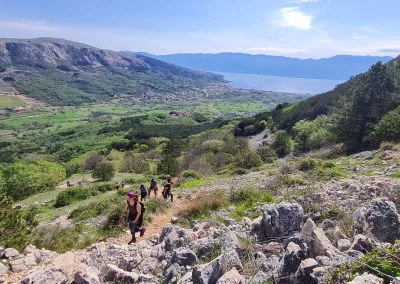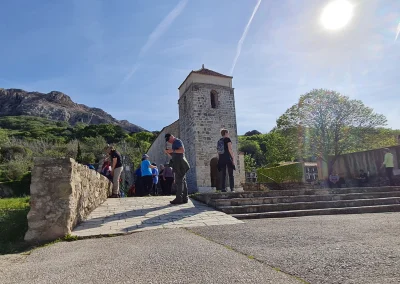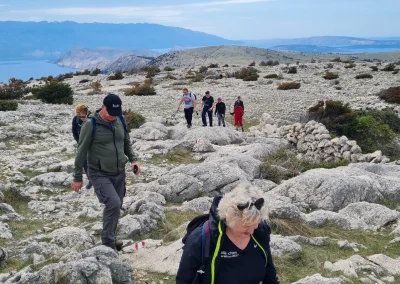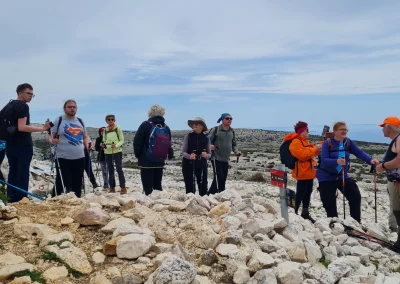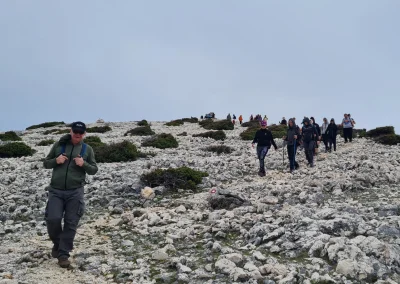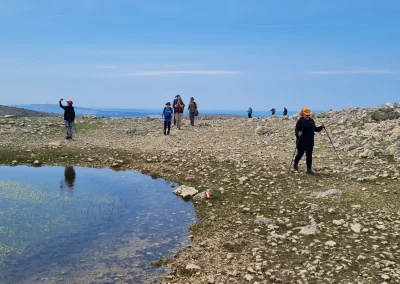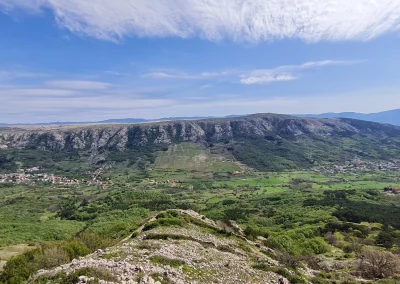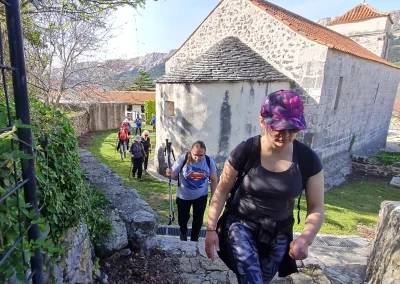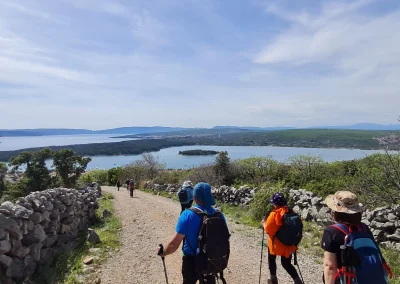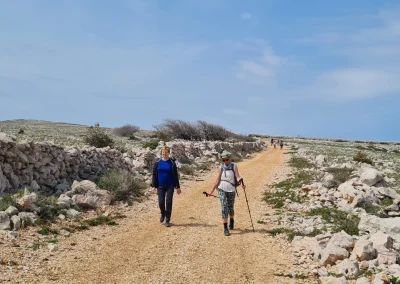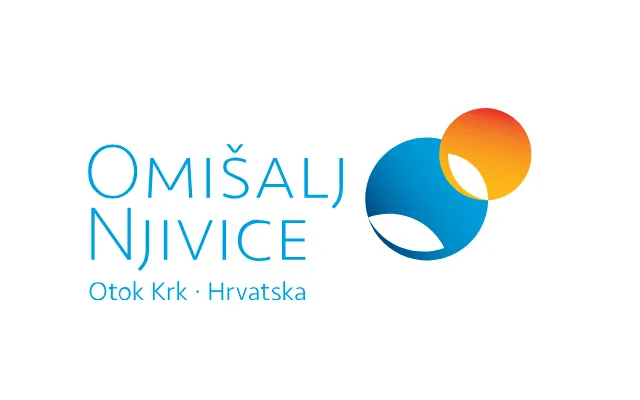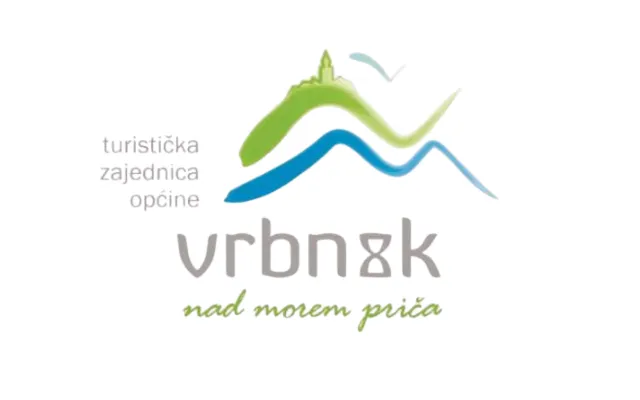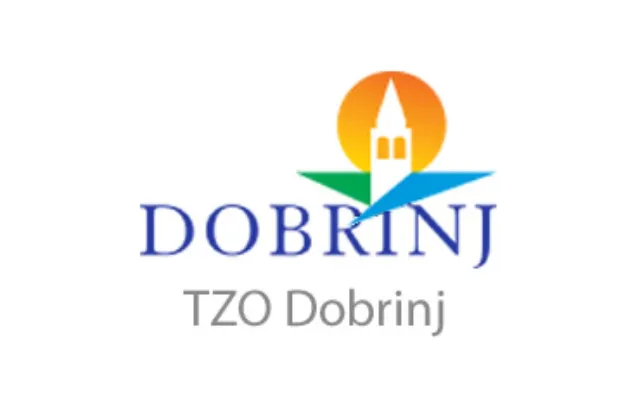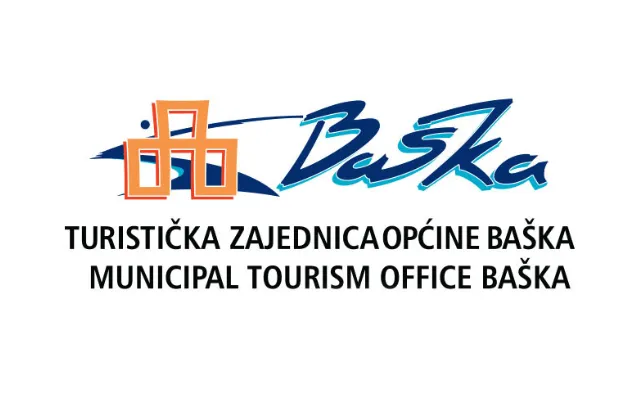
Camino Krk Hike Trails
In collaboration with the Confraternity of St. James, we have developed and run guided tours on the Camino Krk trails, offering you a unique opportunity to explore the beauty of the island of Krk through the prism of historical and cultural landmarks. These trails lead through picturesque landscapes, hidden bays and a rich heritage, allowing you to feel the spirit of the island as you encounter its most precious attractions. At every turn, you will discover historical relics, from Roman remains to medieval churches, while our experienced guides orient you through this extraordinary adventure that refreshes the mind and body. Join us on a journey that will inspire and enrich you, as we explore weekends on the Camino Krk trails together.
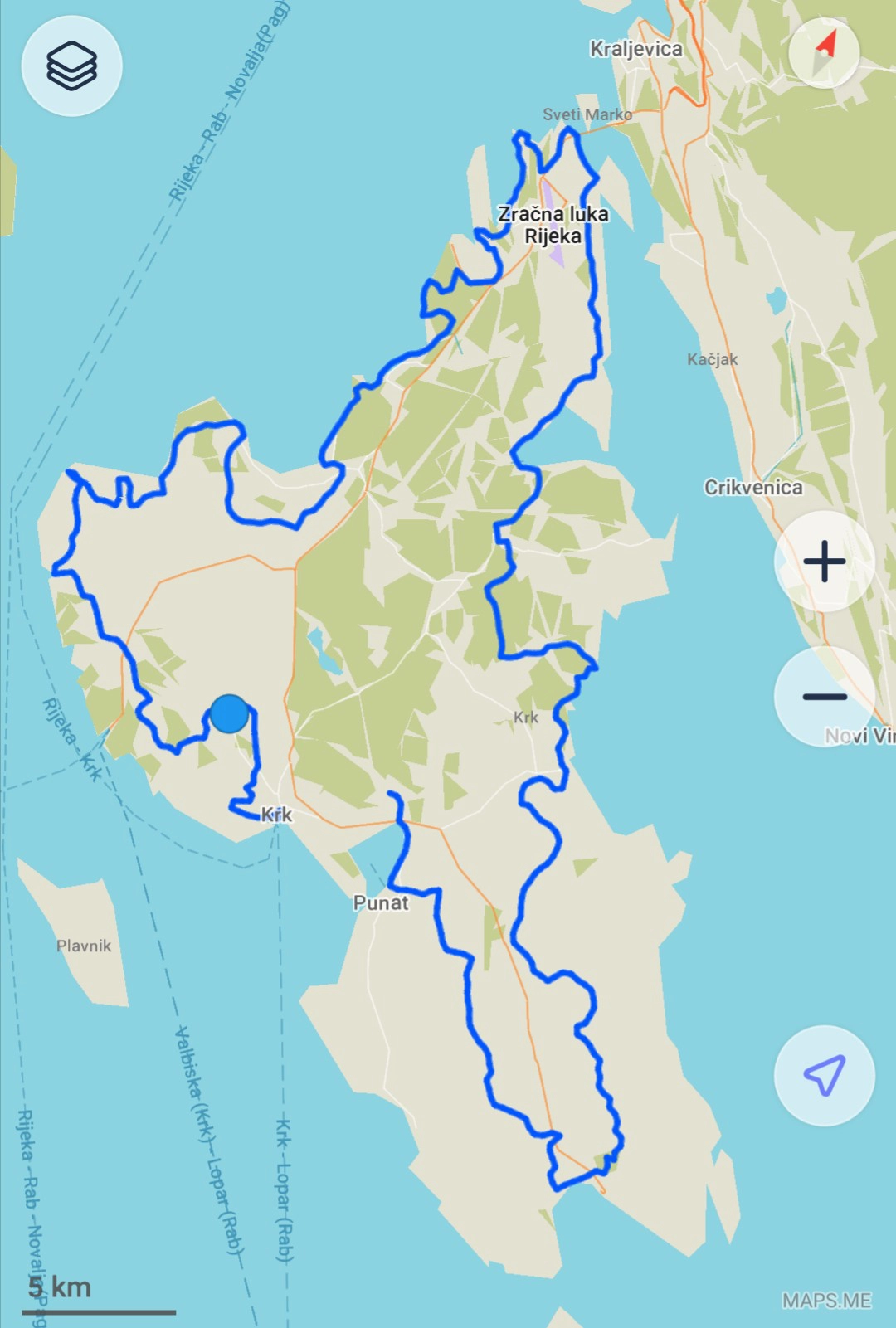
Camino Krk
Welcome to Camino Krk – a unique pilgrimage through the history, nature, and culture of our beautiful island. This route takes you through picturesque villages, sacred and archaeological sites, forest trails, coastal promenades, and peaceful coves, combining a spiritual journey with an outdoor adventure.
On Camino Krk, you will experience a blend of past and present – from ancient Roman ruins and early Christian churches to Romanesque and Baroque sacred sites, and the centuries-old traditions of viticulture, olive growing, and fishing that have shaped the island. Each stage of the route reveals breathtaking landscapes: cliffs and coves, forests and dry-stone walls, mountain viewpoints, and sandy beaches, offering an authentic experience of Krk Island.
Whether you are a devoted pilgrim, a nature lover, or a traveler eager to explore cultural treasures, Camino Krk offers a journey that combines physical challenge with spiritual discovery. Get ready for unforgettable moments, fascinating stories of local places, and the beauty that only Krk Island can offer.
Along the route, pilgrims have the opportunity to collect stamps at various significant sites. These stamps are placed in your pilgrimage passport, serving as a personal record of your journey and a memorable keepsake of the places you have visited. Each stamp marks a milestone, encouraging you to explore, reflect, and fully experience the rich cultural and natural heritage of the island.
Distance
22.7 km
Total ascent / descent
564 m / -436 m
Highest / lowest point
232 m / 1 m
Average walking time
5-6 h
Terrain type
Asphalt, gravel, forest path
Our Camino Krk begins in the vibrant town of Krk, the heart of the island. The first stage leads us through picturesque villages and natural landscapes all the way to Brzac, covering 23 kilometers. Along the way, we connect rich history, sacred heritage, and the diverse scenery of the island.
We start from the old town center, passing the impressive Krk Cathedral and two churches – St. Quirinus and St. Margaret. At Kamplin Square, we will visit the Frankopan Castle, the residence of the famous noble family, and stroll the narrow streets that preserve precious traces of the past. We pass by the Maritime Heritage Interpretation Center, the Upper Town Gates, the Franciscan and Benedictine monasteries, and the Romanesque Church of Our Lady of Good Health.
Walking through the old streets, we reach Veli Plac, the main town square with a rich Roman legacy. The route continues along the waterfront and through olive groves toward the village of Vrh, where we can see the parish church of St. Michael the Archangel. Along the way, we encounter the remains of St. Mary’s Church and the old Salatići Castle.
The trail then leads us through Skrbčići and Pinezići, entering the forested Šotoventa area and reaching St. Fuska Bay. We will explore the remains of the former settlement of Kambun, and the first stage concludes in the peaceful setting of Vela Jana Bay, arriving finally in Brzac.
Distance
22.9 km
Total ascent / descent
452 m / -585 m
Highest / lowest point
137 m / 1 m
Average walking time
6-7 h
Terrain type
Asphalt, gravel, forest path
We will start from Brzac and head toward Glavotok, which was once the summer residence of the Frankopan princes of Krk. Here, we will see a 15th-century monastery and church, and if we venture into the forest, we will discover the small Church of St. Krševan above Čavlena Bay – a true gem of Romanesque architecture. Nearby stands the oldest and largest oak on the island, perfect for photographs and a short rest.
The trail continues along the coastline and forest paths to the Fumak viewpoint, offering breathtaking views of the surrounding area. Next, we reach Porat, a settlement that grew around the Franciscan monastery. Here, we can explore a small museum, an old olive mill (toš), a collection of sacred art, and a Glagolitic lapidary with reproductions of the most important Croatian Glagolitic monuments.
The route then leads through Dubašnica, where we encounter the Old Cemetery of St. Apollinaris with its impressive stone bell tower. We pass through the villages of Sveti Anton, Milovčići, and Kremenići, and along the way, we see the Chapel of St. Andrew, the oldest preserved chapel in the area.
At the end of the day, we arrive in the picturesque town of Malinska, the center of the Malinska-Dubašnica municipality, marking the conclusion of our second day of pilgrimage. Prepare for stunning scenery, the serenity of the forests, and historical gems to discover step by step!
Distance
19 km
Total ascent / descent
371 m / -294 m
Highest / lowest point
83 m / 0 m
Average walking time
4-5 h
Terrain type
Asphalt, gravel, forest path, beach
The first part of the route leads us along the Paradise Trail, a seaside promenade where we will stop at Kijac Bay to enjoy the view of crystal-clear waters. Next, we reach Njivice, where we can visit the Church of the Nativity of the Blessed Virgin Mary, built at the beginning of the 20th century on the site of earlier sacred structures. Interestingly, this location was already known in ancient times as Poje, home to a large agricultural villa and an early Christian church.
We then continue toward the Mohorov site, where remnants of a late antique dwelling can be seen, before walking through forest paths to Sepen Bay and the ruins of the Roman city of Fulfinum from the 1st century. At the Mirine site, we encounter a monumental early Christian cross-shaped church and a 5th-century necropolis – true historical treasures.
Next, we ascend above the Omišalj Bay to Fortičina, a site preserving remains of a medieval castle and a late antique fortress with a cistern. Descending toward Pesja Bay, we pass through Dubec Park, an example of landscape architecture from the first half of the 20th century.
Finally, we arrive in the heart of Omišalj, where the picturesque Church of St. Helena and the Romanesque parish Church of the Assumption of the Blessed Virgin Mary await us – true gems of the island’s sacred heritage.
Distance
21 km
Total ascent / descent
343 m / -419 m
Highest / lowest point
103 m / 0 m
Average walking time
5-6 h
Terrain type
Asphalt, gravel, forest path, sandy beach
The route takes us through settlements and along the coastline, passing by Večja, Martinj, and Lučica Bays. Along the southern edge of Omišalj Camp, we reach the junction leading to Rijeka Airport. From here, the trail ascends through sparse vegetation up to the Krk Bridge, near the small bare islet of Sveti Marko – a perfect spot to enjoy the view.
After the ascent, we descend to Voz Bay and the Vošćica Peninsula, where the foundations of an ancient building and the Maltempo fortress can be seen, originally built by the Venetians to control maritime traffic in the Tihy Channel. On the Kapelica hill, there is a watchtower and the remains of a long building with a side entrance, nearby ecological fields of immortelle grow – a fragrant taste of nature.
The path then follows the rocky northeastern coastline along the Vinodol Channel to Slivanjska Bay, one of the most beautiful sandy beaches on the island. Along the way, we will also visit Biserujka Cave, famous for its rich stalactites and calcite pillars – a natural gem not to be missed.
The route continues through Rudine and forested areas within the municipality of Dobrinj until we reach Čižići, where the remains of St. Peter’s Church await us – a beautiful conclusion to the day and this stage of the Camino.
Distance
21.6 km
Total ascent / descent
632 m / -590 m
Highest / lowest point
266 m / 0 m
Average walking time
5-6 h
Terrain type
Asphalt, gravel, forest path
We start along the famous coastal promenade between Čižići and Soline, with a stunning view of Soline Cove, known for its shallow and warm waters – a perfect spot for a few photos and a deep breath of fresh sea air. A little further, at the Meline site, you can experience the famous black medicinal mud, while on the hill above Soline stands the Romanesque Church of St. Philip and St. Jacob, a reminder of one of Dobrinj’s oldest settlements.
The trail then leads through the center of the Dobrinj municipality, where the parish Church of St. Stephen dominates the view. Nearby, you can also see the Baroque bell tower and the Church of the Holy Trinity with its old cemetery. A short walk takes us to St. Vitus of Dobrinj, one of the few churches with a massive stone bell tower – a true architectural marvel.
Next, the path leads to the Slipica Waterfalls – a natural gem in the island’s interior, where you can enjoy the view of the waterfall and the refreshing forest environment.
The trail continues through the forest and reaches the village of Dolovo, a small abandoned and authentic island settlement with a peaceful atmosphere and deserted houses. We then proceed to Kaštel Gradec, the remains of a medieval fortress from which the famous Frankopan princes originated. It once served to monitor this part of the island and offers a breathtaking panoramic view of the surrounding landscape.
We finish in Vrbnik, known as the birthplace of Glagolitic script and for its rich cultural heritage. The old town center includes the parish Church of the Assumption of the Blessed Virgin Mary, Klančić – the narrowest street in the world – and the remains of medieval walls. Our route ends at the Church of St. John the Baptist, with the nearby remains of St. Maurus Church in the Vrbnik Field – a beautiful conclusion to the day and an excellent spot to rest and explore.
Distance
23.3 km
Total ascent / descent
730 m / -756 m
Highest / lowest point
397 m / 13 m
Average walking time
5-6 h
Terrain type
Asphalt, gravel, forest path
Today we set off from Vrbnik and pass through the Vrbnik Field, famous for centuries-old cultivation of noble grape varieties – every step brings the scent and tradition of the vineyard region.
Our route leads to the Vele Rike springs, offering a stunning view of Vrbnik Field and Vrbnik itself. Particularly striking are the dry stone walls and stone heaps guiding us to the so-called “Moon Plateau” – a rocky, infertile area whose appearance truly resembles the surface of the Moon.
North of the plateau lies the Kuntrep Ornithological Reserve, the oldest ornithological reserve in the world, renowned for the protection of griffon vultures. From here, the Moon Trail takes us toward Baška, through the forest to the Church of St. John the Baptist, the patron saint of the parish and municipality.
As we descend toward the center of Baška, we discover three more significant sacred sites: the Parish Church of the Holy Trinity, the Church of St. Anthony of Padua, and the Chapel of St. Mark, beneath which lie the remains of a monumental early Christian basilica and baptismal font. This stage concludes in the very heart of Baška – a perfect place to rest and enjoy the view of a location where tradition and nature live in harmony.
Distance
21.4 km
Total ascent / descent
779 m / -709 m
Highest / lowest point
569 m / 0 m
Average walking time
6-7 h
Terrain type
Asphalt, gravel, forest path, rocky krast
Welcome to the seventh day of our pilgrimage! Today we set off from Baška and travel through the beautiful island landscapes toward Kornić. We begin along the Baška Glagolitic Trail, following the installed sculptures until we reach Jurandvor, famous for the Baška Tablet – a stone artifact from 1100, one of the most important symbols of Croatian literacy and sovereignty.
We continue westward to Batomalj, home to the largest diocesan Marian sanctuary, one of the oldest in Croatia. From there, we ascend to the restored Lipica mrgari (stone shelters), and the trail passes through sparse vegetation toward Obzova and Veli vrh, offering breathtaking views of the islet Košljun and Kornić – important pilgrimage sites.
The route toward Punat takes us past the Stations of the Cross. Here it is worth visiting the Toš Gallery and the Old Toš Olive Growing Interpretation Center, the Parish Church of the Holy Trinity, and two votive churches – St. Roch in the main square and St. Nicholas in Buka. The islet of Košljun, located in Puntarska Draga, is a true spiritual oasis with a Franciscan monastery and the Renaissance Church of the Annunciation of the Blessed Virgin Mary. The monastery houses a museum with ethnographic, archaeological, and sacred objects, as well as a library with over 30,000 books.
On the way to the final pilgrimage point, we pass the archaeological site in Kanajt and the remains of the three-apsed Romanesque Church of St. Donatus. The stage concludes in Kornić, within the town of Krk, at the Parish Church of St. James the Apostle – the place where we bring yet another unforgettable chapter of our pilgrimage adventure to an end.
